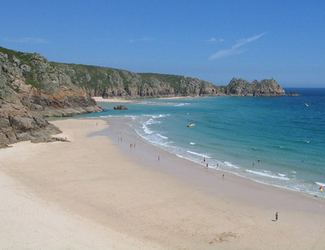stay guide cornwall

Porthcurno
The name Porthcurno evolved from the earlier spelling 'Porth Kernow' or 'Porth Curnow' which in Cornish means 'Port (or Bay) of Cornwall'. Porthcurno is a small village in the parish of St Levan in the very far west of Cornwall. In the late nineteenth century, Porthcurno became internationally known as a centre for international communications. Today, a white granite pyramid atop the cliff between Porthcurno and Logan Rock marks the spot where a hut which housed the termination of a submarine telegraph cable once stood. Porthcurno, its surrounding cliffs and coastline are designated as an Area of Outstanding Natural Beauty. The views are widely considered to be some of the most visually stunning in the United Kingdom and as such, this is a fantastic location for keen walkers. The village has a sub-post office and general stores nearby, as well as a small café and ice cream stand near the car park (open only during the peak summer season). The National Trust own, preserve and maintain the coastal areas around Porthcurno, including those formerly owned by Cable and Wireless. The nearby cliffs rise to 60 m to 70 m above mean sea level and are formed from a bedrock of prismatic granite; over the geological timescales having been eroded, shaped and divided vertically and horizontally sometimes almost into rounded cubic blocks. An ancient bridleway, probably an early route to Porthcurno beach via the nearby Trendrennen Farm (about half a mile to the east of the village) has been opened by the Ramblers Association. The track was probably used by horse-drawn carts to collect seaweed to be used for land fertilisation. For over one hundred years, the area was dominated by the operations of the cable station owned by Cable and Wireless plc and its predecessor companies. Probably over 90% of the inhabitants were either employees of Cable and Wireless or were directly supported by it. During the Second World War, Porthcurno was designated a 'Vulnerable Point' and was heavily defended and fortified as a part of British anti-invasion preparations. There was even a platoon of 300 soldiers deployed to guard the station who camped on a former bowling green in the area. Any local who had business in the area was issued with a pass so that they could pass through. The defences included pillboxes and a petroleum warfare beach flame barrage which could be operated remotely from the tunnel. At the end of the War, although some 867 bombs fell in the Penzance area and 3957 houses were damaged or destroyed, the only damage suffered by any communications equipment at Porthcurno was the destruction of an antenna when a bomb fell about half a mile to the west of the cable office.


 Activities
Activities Beach Guide
Beach Guide Entertainment
Entertainment Food and Drink
Food and Drink Places of Interest
Places of Interest Shopping
Shopping Holiday Services
Holiday Services